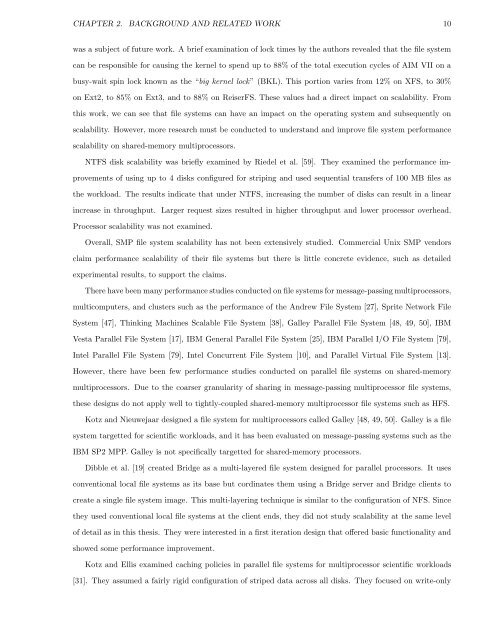Performance Analysis and Optimization of the Hurricane File System ...
Performance Analysis and Optimization of the Hurricane File System ...
Performance Analysis and Optimization of the Hurricane File System ...
Create successful ePaper yourself
Turn your PDF publications into a flip-book with our unique Google optimized e-Paper software.
CHAPTER 2. BACKGROUND AND RELATED WORK 10<br />
was a subject <strong>of</strong> future work. A brief examination <strong>of</strong> lock times by <strong>the</strong> authors revealed that <strong>the</strong> file system<br />
can be responsible for causing <strong>the</strong> kernel to spend up to 88% <strong>of</strong> <strong>the</strong> total execution cycles <strong>of</strong> AIM VII on a<br />
busy-wait spin lock known as <strong>the</strong> “big kernel lock” (BKL). This portion varies from 12% on XFS, to 30%<br />
on Ext2, to 85% on Ext3, <strong>and</strong> to 88% on ReiserFS. These values had a direct impact on scalability. From<br />
this work, we can see that file systems can have an impact on <strong>the</strong> operating system <strong>and</strong> subsequently on<br />
scalability. However, more research must be conducted to underst<strong>and</strong> <strong>and</strong> improve file system performance<br />
scalability on shared-memory multiprocessors.<br />
NTFS disk scalability was briefly examined by Riedel et al. [59]. They examined <strong>the</strong> performance im-<br />
provements <strong>of</strong> using up to 4 disks configured for striping <strong>and</strong> used sequential transfers <strong>of</strong> 100 MB files as<br />
<strong>the</strong> workload. The results indicate that under NTFS, increasing <strong>the</strong> number <strong>of</strong> disks can result in a linear<br />
increase in throughput. Larger request sizes resulted in higher throughput <strong>and</strong> lower processor overhead.<br />
Processor scalability was not examined.<br />
Overall, SMP file system scalability has not been extensively studied. Commercial Unix SMP vendors<br />
claim performance scalability <strong>of</strong> <strong>the</strong>ir file systems but <strong>the</strong>re is little concrete evidence, such as detailed<br />
experimental results, to support <strong>the</strong> claims.<br />
There have been many performance studies conducted on file systems for message-passing multiprocessors,<br />
multicomputers, <strong>and</strong> clusters such as <strong>the</strong> performance <strong>of</strong> <strong>the</strong> Andrew <strong>File</strong> <strong>System</strong> [27], Sprite Network <strong>File</strong><br />
<strong>System</strong> [47], Thinking Machines Scalable <strong>File</strong> <strong>System</strong> [38], Galley Parallel <strong>File</strong> <strong>System</strong> [48, 49, 50], IBM<br />
Vesta Parallel <strong>File</strong> <strong>System</strong> [17], IBM General Parallel <strong>File</strong> <strong>System</strong> [25], IBM Parallel I/O <strong>File</strong> <strong>System</strong> [79],<br />
Intel Parallel <strong>File</strong> <strong>System</strong> [79], Intel Concurrent <strong>File</strong> <strong>System</strong> [10], <strong>and</strong> Parallel Virtual <strong>File</strong> <strong>System</strong> [13].<br />
However, <strong>the</strong>re have been few performance studies conducted on parallel file systems on shared-memory<br />
multiprocessors. Due to <strong>the</strong> coarser granularity <strong>of</strong> sharing in message-passing multiprocessor file systems,<br />
<strong>the</strong>se designs do not apply well to tightly-coupled shared-memory multiprocessor file systems such as HFS.<br />
Kotz <strong>and</strong> Nieuwejaar designed a file system for multiprocessors called Galley [48, 49, 50]. Galley is a file<br />
system targetted for scientific workloads, <strong>and</strong> it has been evaluated on message-passing systems such as <strong>the</strong><br />
IBM SP2 MPP. Galley is not specifically targetted for shared-memory processors.<br />
Dibble et al. [19] created Bridge as a multi-layered file system designed for parallel processors. It uses<br />
conventional local file systems as its base but cordinates <strong>the</strong>m using a Bridge server <strong>and</strong> Bridge clients to<br />
create a single file system image. This multi-layering technique is similar to <strong>the</strong> configuration <strong>of</strong> NFS. Since<br />
<strong>the</strong>y used conventional local file systems at <strong>the</strong> client ends, <strong>the</strong>y did not study scalability at <strong>the</strong> same level<br />
<strong>of</strong> detail as in this <strong>the</strong>sis. They were interested in a first iteration design that <strong>of</strong>fered basic functionality <strong>and</strong><br />
showed some performance improvement.<br />
Kotz <strong>and</strong> Ellis examined caching policies in parallel file systems for multiprocessor scientific workloads<br />
[31]. They assumed a fairly rigid configuration <strong>of</strong> striped data across all disks. They focused on write-only














